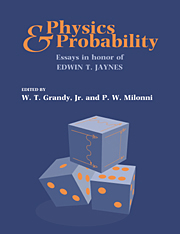Book contents
- Frontmatter
- Contents
- Preface
- Recollections of an Independent Thinker
- A Look Back: Early Applications of Maximum Entropy Estimation to Quantum Statistical Mechanics
- The Jaynes–Cummings Revival
- The Jaynes–Cummings Model and the One-Atom-Maser
- The Jaynes–Cummings Model is Alive and Well
- Self-Consistent Radiation Reaction in Quantum Optics – Jaynes' Influence and a New Example in Cavity QED
- Enhancing the Index of Refraction in a Nonabsorbing Medium: Phaseonium Versus a Mixture of Two-Level Atoms
- Ed Jaynes' Steak Dinner Problem II
- Source Theory of Vacuum Field Effects
- The Natural Line Shape
- An Operational Approach to Schrödinger's Cat
- The Classical Limit of an Atom
- Mutual Radiation Reaction in Spontaneous Emission
- A Model of Neutron Star Dynamics
- The Kinematic Origin of Complex Wave Functions
- On Radar Target Identification
- On the Difference in Means
- Bayesian Analysis, Model Selection and Prediction
- Bayesian Numerical Analysis
- Quantum Statistical Inference
- Application of the Maximum Entropy Principle to Nonlinear Systems Far from Equilibrium
- Nonequilibrium Statistical Mechanics
- A Backward Look to the Future
- Appendix: Vita and Bibliography of Edwin T. Jaynes
- Index
Ed Jaynes' Steak Dinner Problem II
Published online by Cambridge University Press: 21 October 2009
- Frontmatter
- Contents
- Preface
- Recollections of an Independent Thinker
- A Look Back: Early Applications of Maximum Entropy Estimation to Quantum Statistical Mechanics
- The Jaynes–Cummings Revival
- The Jaynes–Cummings Model and the One-Atom-Maser
- The Jaynes–Cummings Model is Alive and Well
- Self-Consistent Radiation Reaction in Quantum Optics – Jaynes' Influence and a New Example in Cavity QED
- Enhancing the Index of Refraction in a Nonabsorbing Medium: Phaseonium Versus a Mixture of Two-Level Atoms
- Ed Jaynes' Steak Dinner Problem II
- Source Theory of Vacuum Field Effects
- The Natural Line Shape
- An Operational Approach to Schrödinger's Cat
- The Classical Limit of an Atom
- Mutual Radiation Reaction in Spontaneous Emission
- A Model of Neutron Star Dynamics
- The Kinematic Origin of Complex Wave Functions
- On Radar Target Identification
- On the Difference in Means
- Bayesian Analysis, Model Selection and Prediction
- Bayesian Numerical Analysis
- Quantum Statistical Inference
- Application of the Maximum Entropy Principle to Nonlinear Systems Far from Equilibrium
- Nonequilibrium Statistical Mechanics
- A Backward Look to the Future
- Appendix: Vita and Bibliography of Edwin T. Jaynes
- Index
Summary
ABSTRACT. During the Spring of 1966, Ed Jaynes presented a seminar course on quantum electronics that included the now famous “Jaynes-Cummings Model” and his Neoclassical Theory (NCT). As part of this seminar series, the NCT description of a two-level atom in an applied field was formulated as a formidable set of coupled nonlinear differential equations. Undaunted, Ed posted the equations on the Washington University Physics Department bulletin board and offered a prize of “a steak dinner for two” at a restaurant of the choice of the person who solves the equations. Within days, Bill Mitchell was able to present an elegant solution at one of the quantum electronics seminars. This early success of a new approach to doing theoretical physics encouraged Ed to challenge the knowledge hungry Physics Department with Steak Dinner Problem II. This problem was a specific mathematical formulation of the exact (i.e. without the Rotating Wave Approximation) description of the interaction of a two-level atom with a single quantized electromagnetic field mode. Jaynes' formulation of the problem appears to have anticipated the use of Bargmann Hilbert space in QED. This problem has remained unsolved for 26 years in spite of the efforts of numerous researchers, most of whom were probably unaware of Jaynes' offered prize. Recent efforts to solve this problem will be described.
“If it were easy, it would already have been done.”
… E.T. Jaynes, 1966.- Type
- Chapter
- Information
- Physics and ProbabilityEssays in Honor of Edwin T. Jaynes, pp. 81 - 90Publisher: Cambridge University PressPrint publication year: 1993
- 2
- Cited by



